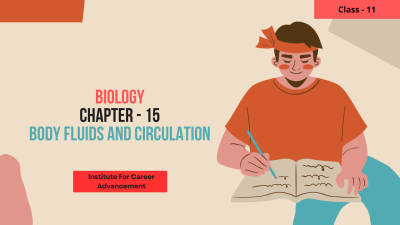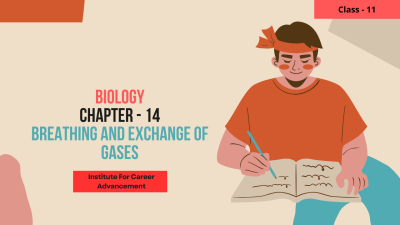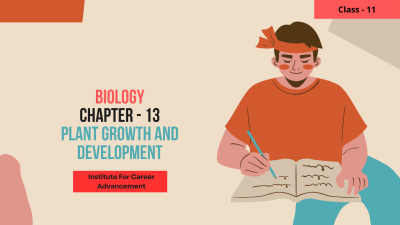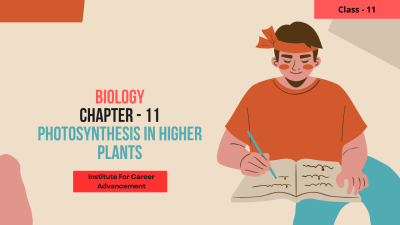Courses


 Compare
Compare
Your body is a busy city, constantly working and producing waste! But unlike throwing things away, your body has a special way to get rid of unwanted materials. In Class 11 Biology, you'll explore the fascinating world of Excretory Products and Their Elimination, learning how your body efficiently removes waste products to stay healthy. The Culprits: Metabolic Waste: As your body breaks down food for energy, it creates byproducts like ammonia, urea, and carbon dioxide. These need to be eliminated. The Disposal Options: Different organisms have evolved various ways to deal with waste. You'll learn about three main categories: Ammonotelic: Ammonia disposal (mostly aquatic animals) Ureotelic: Urea disposal (mammals like us) Uricotelic: Uric acid disposal (birds, reptiles) Your Body's Cleanup Crew: The Excretory System: This amazing system works tirelessly to filter and remove waste products from your blood. The key players include: Kidneys: Filter waste and excess water from blood, producing urine. Lungs: Eliminate carbon dioxide, a gas produced during cellular respiration. Skin: Sweats out excess water, salts, and some waste products. Why It Matters: By eliminating waste, your body maintains a healthy internal environment, preventing buildup of toxic substances and ensuring proper cell function. আপনার শরীর একটি ব্যস্ত শহর, ক্রমাগত কাজ করে এবং বর্জ্য উৎপাদন করে! কিন্তু জিনিসগুলি ফেলে দেওয়ার বিপরীতে, আপনার শরীরের অবাঞ্ছিত পদার্থগুলি থেকে মুক্তি পাওয়ার একটি বিশেষ উপায় রয়েছে। ক্লাস 11 বায়োলজিতে, আপনি বর্জ্য পণ্য এবং তাদের নির্মূলের আকর্ষণীয় জগৎটি অন্বেষণ করবেন, শিখবেন কিভাবে আপনার শরীর সুস্থ থাকার জন্য বর্জ্য পণ্যগুলি দক্ষতার সাথে সরিয়ে দেয়। দোষীদেরঃ বিপাকীয় বর্জ্যঃ আপনার শরীর যখন শক্তির জন্য খাবার ভেঙে দেয়, তখন এটি অ্যামোনিয়া, ইউরিয়া এবং কার্বন ডাই অক্সাইডের মতো উপজাত তৈরি করে। এগুলো দূর করতে হবে। নিষ্পত্তি বিকল্পগুলিঃ বিভিন্ন জীব বর্জ্য মোকাবেলার জন্য বিভিন্ন উপায় উদ্ভাবন করেছে। আপনি তিনটি প্রধান বিভাগ সম্পর্কে শিখবেনঃ অ্যামোনোটেলিকঃ অ্যামোনিয়া অপসারণ (mostly aquatic animals) ইউরিওটেলিকঃ ইউরিয়া অপসারণ (mammals like us) ইউরিকোটেলিকঃ ইউরিক অ্যাসিড নিষ্কাশন (birds, reptiles) আপনার দেহের পরিচ্ছন্নতার কর্মীদলঃ বর্জ্য ব্যবস্থাঃ এই বিস্ময়কর ব্যবস্থাটি আপনার রক্ত থেকে বর্জ্য পদার্থগুলি ফিল্টার এবং অপসারণ করতে অক্লান্ত পরিশ্রম করে। মূল খেলোয়াড়দের মধ্যে রয়েছেঃ কিডনিঃ রক্ত থেকে বর্জ্য এবং অতিরিক্ত জল ফিল্টার করে প্রস্রাব তৈরি করে। ফুসফুসঃ কার্বন ডাই অক্সাইড দূর করে, যা কোষীয় শ্বাস-প্রশ্বাসের সময় উৎপাদিত একটি গ্যাস। ত্বকঃ অতিরিক্ত জল, লবণ এবং কিছু বর্জ্য পদার্থ ঘাম ঝরিয়ে দেয়। কেন এটি গুরুত্বপূর্ণঃ বর্জ্য অপসারণের মাধ্যমে, আপনার শরীর একটি স্বাস্থ্যকর অভ্যন্তরীণ পরিবেশ বজায় রাখে, বিষাক্ত পদার্থের গঠন প্রতিরোধ করে এবং সঠিক কোষের কার্যকারিতা নিশ্চিত করে।
0 Lessons
Hours

 Compare
Compare
Your body is like a bustling city with constant traffic! But instead of cars, it's fluids that keep everything running smoothly. In Class 11 Biology, you'll delve into the world of Body Fluids and Circulation, exploring the essential fluids and the amazing circulatory system that transports them throughout your body. The Players: Blood: The star of the show! Blood is a fluid tissue made up of plasma (the liquid part) and cells like red blood cells (carry oxygen), white blood cells (fight infection), and platelets (help with clotting). Lymph: The lesser-known hero! Lymph is a fluid that collects waste products and transports them to the bloodstream. The Highway System: Circulatory System: This complex network of blood vessels (arteries, veins, and capillaries) carries blood throughout the body. Double Circulation: Unlike some simpler systems, humans have a double circulation system. Blood passes through the heart twice in one complete circuit, ensuring efficient delivery of oxygen and nutrients. Keeping Things Moving: The Heart: The powerful pump that keeps blood flowing through the circulatory system. Why It Matters: This intricate system is vital for delivering oxygen, nutrients, and hormones to all your cells and tissues. It also removes waste products and helps regulate body temperature. আপনার শরীর যেন একটানা যানজটের শহর! কিন্তু গাড়ির পরিবর্তে, তরল পদার্থই সবকিছু মসৃণভাবে চালিয়ে যায়। ক্লাস 11 বায়োলজিতে, আপনি দেহের তরল এবং সঞ্চালনের জগতে প্রবেশ করবেন, প্রয়োজনীয় তরল এবং আশ্চর্যজনক সংবহন ব্যবস্থা অন্বেষণ করবেন যা সেগুলিকে আপনার সারা শরীর জুড়ে পরিবহন করে। খেলোয়াড়রাঃ রক্তঃ দ্য স্টার অফ দ্য শো! রক্ত হল একটি তরল টিস্যু যা প্লাজমা (তরল অংশ) এবং লোহিত রক্তকণিকা (অক্সিজেন বহনকারী) শ্বেত রক্তকণিকা (সংক্রমণের বিরুদ্ধে লড়াই) এবং প্লেটলেট দ্বারা গঠিত। (help with clotting). লিম্ফঃ কম পরিচিত নায়ক! লিম্ফ হল একটি তরল যা বর্জ্য পদার্থ সংগ্রহ করে এবং সেগুলিকে রক্ত প্রবাহে পরিবহন করে। মহাসড়ক ব্যবস্থাঃ রক্ত সঞ্চালন ব্যবস্থাঃ রক্তবাহী জাহাজের এই জটিল নেটওয়ার্ক (ধমনী, শিরা এবং কৈশিক) সারা শরীর জুড়ে রক্ত বহন করে। ডাবল সার্কুলেশনঃ কিছু সহজ পদ্ধতির বিপরীতে, মানুষের একটি ডাবল সার্কুলেশন ব্যবস্থা রয়েছে। রক্ত একটি সম্পূর্ণ বর্তনীতে হৃৎপিণ্ডের মধ্য দিয়ে দুবার যায়, যা অক্সিজেন এবং পুষ্টির দক্ষ বিতরণ নিশ্চিত করে। জিনিসগুলি সচল রাখাঃ হার্টঃ শক্তিশালী পাম্প যা রক্ত সঞ্চালন ব্যবস্থার মধ্য দিয়ে প্রবাহিত রাখে। কেন এটি গুরুত্বপূর্ণঃ এই জটিল ব্যবস্থাটি আপনার সমস্ত কোষ এবং টিস্যুতে অক্সিজেন, পুষ্টি এবং হরমোন সরবরাহের জন্য অত্যাবশ্যক। এটি বর্জ্য পদার্থও অপসারণ করে এবং শরীরের তাপমাত্রা নিয়ন্ত্রণ করতে সহায়তা করে।
0 Lessons
Hours

 Compare
Compare
All living things need oxygen to survive, and plants are no exception! But unlike us animals with lungs, plants have a different way to breathe. Here's a quick look at how gas exchange works in plants for Class 11: The Need for Air: Plants use oxygen (O₂) for cellular respiration, just like us. They also release carbon dioxide (CO₂) as a waste product during this process. No Lungs, No Problem: Plants don't have lungs, but they have tiny pores on their leaves called stomata (singular: stoma) and similar structures on stems called lenticels. These pores act like microscopic air vents for gas exchange. The Breathing Process: Taking in Oxygen: During the day, stomata open to allow oxygen from the atmosphere to diffuse into the plant. Releasing Carbon Dioxide: At the same time, carbon dioxide produced by cellular respiration diffuses out of the plant through the stomata and lenticels. The CO₂ Twist: This released CO₂ is actually used by plants themselves for photosynthesis during the day! It's a cool recycling trick. Factors at Play: Light, temperature, and water availability can all influence how much a plant "breathes" by affecting the opening and closing of stomata. The Takeaway: Even though breathing in plants seems simpler than in animals, it's an essential process for their survival and growth. It's all about taking in what they need and getting rid of waste! সব জীবের বেঁচে থাকার জন্য অক্সিজেনের প্রয়োজন, এবং গাছপালাও এর ব্যতিক্রম নয়! প্রাণীদের থেকে ভিন্ন, উদ্ভিদের শ্বাস-প্রশ্বাসের পদ্ধতি আলাদা। ক্লাস 11-এর জন্য কারখানাগুলিতে গ্যাস এক্সচেঞ্জ কীভাবে কাজ করে তা এখানে দ্রুত দেখুনঃ বাতাসের প্রয়োজনীয়তাঃ উদ্ভিদ আমাদের মতো কোষীয় শ্বাস-প্রশ্বাসের জন্য অক্সিজেন (O2) ব্যবহার করে। তারা এই প্রক্রিয়া চলাকালীন বর্জ্য পণ্য হিসাবে কার্বন ডাই অক্সাইড (সিও 2) ছেড়ে দেয়। কোন সমস্যা নেই, কোন সমস্যা নেইঃ উদ্ভিদের ফুসফুস নেই, তবে তাদের পাতায় ছোট ছোট ছিদ্র রয়েছে যা স্টোমাটা (একবচনঃ স্টোমা) এবং কান্ডের উপর অনুরূপ কাঠামো রয়েছে যাকে লেন্টিসেল বলা হয়। এই ছিদ্রগুলি গ্যাস বিনিময়ের জন্য মাইক্রোস্কোপিক বায়ু ভেন্টের মতো কাজ করে। শ্বাস-প্রশ্বাসের প্রক্রিয়াঃ অক্সিজেন গ্রহণঃ দিনের বেলায়, বায়ুমণ্ডল থেকে অক্সিজেনকে উদ্ভিদে ছড়িয়ে দেওয়ার জন্য স্টোমাটা খোলা থাকে। কার্বন ডাই অক্সাইড মুক্ত করাঃ একই সময়ে, কোষীয় শ্বসন দ্বারা উত্পাদিত কার্বন ডাই অক্সাইড উদ্ভিদ থেকে স্টোমাটা এবং মসুর ডালের মাধ্যমে ছড়িয়ে পড়ে। CO2 টুইস্টঃ এই মুক্ত CO2 আসলে উদ্ভিদ দ্বারা দিনের বেলা সালোকসংশ্লেষণের জন্য ব্যবহার করা হয়! এটি একটি চমৎকার পুনর্ব্যবহারযোগ্য কৌশল। খেলার কারণগুলিঃ আলো, তাপমাত্রা এবং জলের সহজলভ্যতা স্টোমাটার খোলার এবং বন্ধকে প্রভাবিত করে একটি উদ্ভিদ কতটা "শ্বাস নেয়" তা প্রভাবিত করতে পারে। গ্রহণযোগ্যঃ যদিও প্রাণীদের তুলনায় উদ্ভিদের শ্বাস-প্রশ্বাস সহজ বলে মনে হয়, এটি তাদের বেঁচে থাকার এবং বৃদ্ধির জন্য একটি অপরিহার্য প্রক্রিয়া। এগুলি হল তাদের যা প্রয়োজন তা গ্রহণ করা এবং বর্জ্য অপসারণ করা!
0 Lessons
Hours

 Compare
Compare
Plants don't just sprout and magically grow! They go through a fascinating process called plant growth and development, which is all about how they increase in size and complexity. This journey is influenced by both internal factors, like special plant hormones, and external factors, like the amount of sunshine they get. Here's a quick look at what you'll discover in Plant Growth and Development for Class 11: The Growth Engine: Meristems Imagine tiny factories inside a plant. These are meristems, regions packed with cells that constantly divide, creating new cells for growth. They're located at the tips of roots and shoots, like little building crews constantly expanding the plant. Two Types of Growth: Lengthwise Stretch: This is primary growth, driven by meristems at the tips, making the plant shoot up and roots dig deeper. Getting Thicker: Secondary growth involves special sideways-growing meristems that add layers of woody tissue, making the plant stronger and wider. Hormonal Control Center Plants don't have brains, but they use chemical messengers called hormones to control growth. Auxin, for example, helps stems grow tall, while other hormones influence root development, leaf growth, and even when leaves fall off. The Environment Matters Light, temperature, and water availability all play a big role in how plants grow. Sunlight fuels photosynthesis for energy, while the right temperature keeps things running smoothly. Water is essential for everything from keeping cells plump to transporting nutrients. From Seed to Plant The journey starts with seed germination, where a tiny seed breaks open and starts to grow into a seedling under the right conditions. Plants can even respond to the day/night cycle (photoperiodism) to know when to flower! গাছপালা কেবল অঙ্কুরিত হয় না এবং জাদুকরীভাবে বৃদ্ধি পায় না! তারা উদ্ভিদের বৃদ্ধি এবং বিকাশ নামে একটি আকর্ষণীয় প্রক্রিয়ার মধ্য দিয়ে যায়, যা কীভাবে তারা আকার এবং জটিলতা বৃদ্ধি করে সে সম্পর্কে। এই যাত্রাটি উদ্ভিদের বিশেষ হরমোনের মতো অভ্যন্তরীণ কারণ এবং সূর্যালোকের পরিমাণের মতো বাহ্যিক কারণ উভয়ের দ্বারা প্রভাবিত হয়। ক্লাস 11-এর জন্য উদ্ভিদ বৃদ্ধি এবং বিকাশে আপনি কী আবিষ্কার করবেন তা এখানে একটি দ্রুত চেহারা দেওয়া হলঃ বৃদ্ধির ইঞ্জিনঃ মেরিস্টেমস একটি কারখানার ভিতরে ছোট ছোট কারখানার কথা কল্পনা করুন। এগুলি মেরিস্টেম, কোষ দ্বারা পূর্ণ অঞ্চল যা ক্রমাগত বিভক্ত হয়, বৃদ্ধির জন্য নতুন কোষ তৈরি করে। এগুলি শিকড় এবং অঙ্কুরের ডগায় অবস্থিত, যেমন ছোট বিল্ডিং ক্রুরা ক্রমাগত উদ্ভিদটি প্রসারিত করে। দুই ধরনের বৃদ্ধিঃ দৈর্ঘ্যের দিকের প্রসারঃ এটি প্রাথমিক বৃদ্ধি, যা অগ্রভাগে মেরিস্টেম দ্বারা চালিত হয়, যার ফলে উদ্ভিদটি অঙ্কুরিত হয় এবং শিকড়গুলি আরও গভীর খনন করে। পুরু হওয়াঃ গৌণ বৃদ্ধিতে বিশেষ পার্শ্ব-ক্রমবর্ধমান মেরিস্টেম জড়িত থাকে যা কাঠের টিস্যুর স্তর যুক্ত করে, উদ্ভিদকে আরও শক্তিশালী এবং প্রশস্ত করে তোলে। হরমোন নিয়ন্ত্রণ কেন্দ্র উদ্ভিদের মস্তিষ্ক নেই, তবে তারা বৃদ্ধি নিয়ন্ত্রণ করতে হরমোন নামক রাসায়নিক বার্তাবাহক ব্যবহার করে। উদাহরণস্বরূপ, অক্সিন কান্ডগুলিকে লম্বা হতে সাহায্য করে, অন্যদিকে অন্যান্য হরমোনগুলি শিকড়ের বিকাশ, পাতার বৃদ্ধি এবং এমনকি পাতা পড়ে যাওয়ার সময়ও প্রভাবিত করে। পরিবেশের বিষয়গুলি উদ্ভিদের বৃদ্ধিতে আলো, তাপমাত্রা এবং জলের প্রাপ্যতা সবই একটি বড় ভূমিকা পালন করে। সূর্যালোক শক্তির জন্য সালোকসংশ্লেষণে ইন্ধন যোগায়, অন্যদিকে সঠিক তাপমাত্রা জিনিসগুলিকে মসৃণভাবে চলতে রাখে। কোষগুলিকে মোটা রাখা থেকে শুরু করে পুষ্টি পরিবহণ পর্যন্ত সবকিছুর জন্য জল অপরিহার্য। বীজ থেকে গাছে যাত্রাটি শুরু হয় বীজের অঙ্কুরোদগমের মাধ্যমে, যেখানে একটি ক্ষুদ্র বীজ ভেঙে যায় এবং সঠিক পরিস্থিতিতে একটি চারায় পরিণত হতে শুরু করে। গাছপালা এমনকি দিন/রাতের চক্রের (ফটোপেরিওডিজম) প্রতি সাড়া দিয়ে জানতে পারে যে কখন ফুল ফোটে!
0 Lessons
Hours

 Compare
Compare
Plants aren't just breathers of fresh air, they're also secret breathers themselves! Unlike animals, plants don't have lungs, but they do undergo respiration. Here's a quick look: The Need for Energy: Just like us, plants require energy for various functions like growth, repair, and nutrient uptake. Respiration is the process by which they break down organic molecules (usually sugars made during photosynthesis) to release this energy. Not Just About Oxygen: While plants do take in oxygen (O₂) during respiration, they don't have a specialized breathing system. Tiny pores on leaves (stomata) and stems (lenticels) allow for gas exchange. Unlike photosynthesis, respiration happens in all living plant parts – leaves, stems, and even roots. The Release: The breakdown of sugars in respiration releases carbon dioxide (CO₂) as a waste product, which then diffuses back out through the stomata and lenticels. This CO₂ isn't necessarily "bad" – it's actually used by plants themselves for photosynthesis during the day! The Takeaway: Respiration in plants is an essential process, even though it seems to work against photosynthesis. It's a cellular mechanism that provides plants with the energy they need to survive and function, even during the night when photosynthesis isn't happening. গাছপালা কেবল তাজা বাতাসের নিঃশ্বাস নয়, তারা নিজেরাই গোপন শ্বাস-প্রশ্বাসও! প্রাণীদের মতো, উদ্ভিদের ফুসফুস নেই, তবে তারা শ্বাস-প্রশ্বাসের মধ্য দিয়ে যায়। এখানে একটি দ্রুত দেখুনঃ শক্তির প্রয়োজনীয়তাঃ আমাদের মতো উদ্ভিদেরও বৃদ্ধি, মেরামত এবং পুষ্টি গ্রহণের মতো বিভিন্ন কাজের জন্য শক্তির প্রয়োজন হয়। শ্বাস-প্রশ্বাস হল সেই প্রক্রিয়া যার মাধ্যমে তারা এই শক্তি মুক্ত করার জন্য জৈব অণুগুলি (সাধারণত সালোকসংশ্লেষণের সময় তৈরি শর্করা) ভেঙে দেয়। শুধু অক্সিজেন নয়ঃ যদিও উদ্ভিদগুলি শ্বাস-প্রশ্বাসের সময় অক্সিজেন (O2) গ্রহণ করে, তাদের কোনও বিশেষ শ্বাস-প্রশ্বাস ব্যবস্থা নেই। পাতার ছোট ছিদ্র (স্টোমাটা) এবং কান্ড (লেন্টিসেল) গ্যাস বিনিময়ের অনুমতি দেয়। সালোকসংশ্লেষণের বিপরীতে, সমস্ত জীবন্ত উদ্ভিদ অংশে-পাতা, কাণ্ড এবং এমনকি শিকড়েও শ্বাস-প্রশ্বাস ঘটে। মুক্তিঃ শ্বাসকষ্টে শর্করার ভাঙ্গন বর্জ্য পণ্য হিসাবে কার্বন ডাই অক্সাইড (সিও 2) প্রকাশ করে, যা পরে স্টোমাটা এবং লেন্টিসেলের মাধ্যমে ছড়িয়ে পড়ে। এই সিও2 অপরিহার্যভাবে "খারাপ" নয়-এটি আসলে দিনের বেলায় উদ্ভিদ দ্বারা সালোকসংশ্লেষণের জন্য ব্যবহৃত হয়! দ্য টেকওয়েঃ উদ্ভিদগুলিতে শ্বাস-প্রশ্বাস একটি অপরিহার্য প্রক্রিয়া, যদিও এটি সালোকসংশ্লেষণের বিরুদ্ধে কাজ করে বলে মনে হয়। এটি একটি কোষীয় প্রক্রিয়া যা উদ্ভিদকে বেঁচে থাকার এবং কাজ করার জন্য প্রয়োজনীয় শক্তি সরবরাহ করে, এমনকি রাতের বেলাও যখন সালোকসংশ্লেষণ ঘটছে না।
0 Lessons
Hours

 Compare
Compare
Photosynthesis is the amazing process by which higher plants, like the ones you see every day, use sunlight to fuel the creation of their own food! This food, in the form of sugar molecules, is the foundation of life on Earth. Here's a quick look at what goes on inside a plant to make this magic happen: The site of photosynthesis in a plant cell is the chloroplast. These tiny organelles contain chlorophyll, a pigment that gives plants their green color and plays a starring role in capturing the sun's energy. Two-Stage Spectacle Photosynthesis can be broken down into two main stages: The Light-Dependent Reactions (Light Reactions): Here, sunlight is absorbed by chlorophyll, energizing electrons. This energy is then used to produce ATP (adenosine triphosphate) and NADPH (nicotinamide adenine dinucleotide phosphate), which are the energy currencies used in the next stage. The Light-Independent Reactions (Dark Reactions): Even though light isn't directly required here, these reactions are often referred to as the "dark reactions" because they can happen in low light conditions. In this stage, the ATP and NADPH from the light reactions are used to take carbon dioxide from the air and convert it into sugar molecules (glucose) through a series of enzyme-controlled steps. The Big Picture The sugars produced by photosynthesis are used by the plant for growth, repair, and energy. Additionally, some of the sugar is converted into other organic molecules, such as starches and proteins, which are used for storage and building materials. Photosynthesis is also essential for the release of oxygen gas (O₂) into the atmosphere, which is necessary for most forms of life to survive. সালোকসংশ্লেষণ একটি বিস্ময়কর প্রক্রিয়া যার মাধ্যমে উচ্চতর গাছপালা, যেমন আপনি প্রতিদিন দেখেন, তাদের নিজস্ব খাদ্য তৈরির জন্য সূর্যালোক ব্যবহার করে! চিনির অণু আকারে এই খাদ্য পৃথিবীতে জীবনের ভিত্তি। এই জাদু ঘটানোর জন্য একটি উদ্ভিদের ভিতরে কী চলছে তা এখানে দ্রুত দেখুনঃ উদ্ভিদ কোষে সালোকসংশ্লেষণের স্থান হল ক্লোরোপ্লাস্ট। এই ক্ষুদ্র অর্গানেলগুলিতে ক্লোরোফিল রয়েছে, একটি রঞ্জক যা গাছগুলিকে তাদের সবুজ রঙ দেয় এবং সূর্যের শক্তি ধরে রাখতে একটি প্রধান ভূমিকা পালন করে। দ্বি-পর্যায় প্রদর্শনী সালোকসংশ্লেষণকে দুটি প্রধান পর্যায়ে ভাগ করা যেতে পারেঃ হালকা-নির্ভর বিক্রিয়া (হালকা বিক্রিয়া) এখানে, সূর্যালোক ক্লোরোফিল দ্বারা শোষিত হয়, যা ইলেকট্রনকে শক্তিশালী করে। এই শক্তি তারপর এটিপি (অ্যাডেনোসিন ট্রাইফসফেট) এবং এনএডিপিএইচ (নিকোটিনামাইড অ্যাডেনিন ডাইনুক্লিয়টাইড ফসফেট) উৎপাদনে ব্যবহৃত হয় যা পরবর্তী পর্যায়ে ব্যবহৃত শক্তি মুদ্রা। হালকা-স্বাধীন প্রতিক্রিয়া (অন্ধকার প্রতিক্রিয়া) যদিও এখানে সরাসরি আলোর প্রয়োজন হয় না, তবুও এই প্রতিক্রিয়াগুলিকে প্রায়শই "অন্ধকার প্রতিক্রিয়া" হিসাবে উল্লেখ করা হয় কারণ এগুলি কম আলোতে ঘটতে পারে। এই পর্যায়ে, হালকা প্রতিক্রিয়া থেকে এটিপি এবং এনএডিপিএইচ বায়ু থেকে কার্বন ডাই অক্সাইড নিতে এবং এনজাইম-নিয়ন্ত্রিত পদক্ষেপের মাধ্যমে এটিকে চিনির অণুতে (গ্লুকোজ) রূপান্তর করতে ব্যবহৃত হয়। বড় ছবি সালোকসংশ্লেষণ দ্বারা উৎপাদিত শর্করা উদ্ভিদ দ্বারা বৃদ্ধি, মেরামত এবং শক্তির জন্য ব্যবহৃত হয়। উপরন্তু, কিছু চিনি অন্যান্য জৈব অণুতে রূপান্তরিত হয়, যেমন শ্বেতসার এবং প্রোটিন, যা সঞ্চয় এবং নির্মাণ সামগ্রীর জন্য ব্যবহৃত হয়। বায়ুমণ্ডলে অক্সিজেন গ্যাস (O2) মুক্ত করার জন্য সালোকসংশ্লেষণও অপরিহার্য, যা জীবনের বেশিরভাগ রূপের বেঁচে থাকার জন্য প্রয়োজনীয়।
0 Lessons
Hours

 Compare
Compare
The Cell Cycle and Cell Division unit in Class 11 Biology is all about understanding how cells grow, replicate their DNA, and divide to create new daughter cells. Imagine it like a well-orchestrated dance where a cell duplicates itself to ensure the continuation of life! Here's a simplified breakdown: The Big Picture: Cell division is essential for growth, repair, and reproduction in living organisms. The Phases: The cell cycle has two main phases: interphase (the preparation stage) and mitosis (the actual cell division stage). Interphase - Getting Ready: During this longer phase, the cell grows, replicates its DNA, and prepares for division. Mitosis - The Division Act: This dramatic stage involves dividing the replicated DNA and cell contents into two daughter cells, each genetically identical to the parent cell. ক্লাস 11 জীববিজ্ঞানের কোষ চক্র এবং কোষ বিভাগ ইউনিটটি কীভাবে কোষগুলি বৃদ্ধি পায়, তাদের ডিএনএ প্রতিলিপি তৈরি করে এবং নতুন কন্যা কোষ তৈরি করতে বিভক্ত হয় তা বোঝার বিষয়ে। এটিকে একটি সুসংগঠিত নাচের মতো কল্পনা করুন যেখানে জীবনের ধারাবাহিকতা নিশ্চিত করার জন্য একটি কোষ নিজেকে নকল করে! এখানে একটি সরলীকৃত ভাঙ্গন আছেঃ বড় ছবিঃ জীবের বৃদ্ধি, মেরামত এবং প্রজননের জন্য কোষ বিভাজন অপরিহার্য। পর্যায়ঃ কোষচক্রের দুটি প্রধান পর্যায় রয়েছেঃ ইন্টারফেজ (প্রস্তুতির পর্যায়) এবং মাইটোসিস। (the actual cell division stage). ইন্টারফেজ-প্রস্তুত হওয়াঃ এই দীর্ঘ পর্যায়ে, কোষটি বৃদ্ধি পায়, তার ডিএনএ প্রতিলিপি তৈরি করে এবং বিভাজনের জন্য প্রস্তুত হয়। মাইটোসিস-বিভাগ আইনঃ এই নাটকীয় পর্যায়ে প্রতিলিপি করা ডিএনএ এবং কোষের বিষয়বস্তু দুটি কন্যা কোষে বিভক্ত করা হয়, প্রতিটি জিনগতভাবে মূল কোষের অনুরূপ।
0 Lessons
Hours

 Compare
Compare
In Class 11 Biology, Biomolecules introduces you to the essential building blocks and working parts of living things. Imagine them as the bricks and mortar, nuts and bolts, of an organism! Here's a simplified breakdown: The Building Blocks: Biomolecules are organic compounds, meaning they contain carbon, the element that forms the foundation of life. The Major Players: There are four main types of biomolecules you'll encounter: Carbohydrates: Provide energy for cells, like the sugar glucose. Proteins: The workhorses, building tissues, enzymes, and hormones. Nucleic Acids: Store and transmit genetic information (DNA and RNA). Lipids: Store energy, form cell membranes, and have other functions. একাদশ শ্রেণিতে জীববিজ্ঞানে, জৈব অণুগুলি আপনাকে প্রয়োজনীয় বিল্ডিং ব্লক এবং জীবের কার্যকরী অংশগুলির সাথে পরিচয় করিয়ে দেয়। এগুলিকে কোনও জীবের ইট এবং মর্টার, বাদাম এবং বোল্ট হিসাবে কল্পনা করুন! এখানে একটি সরলীকৃত ভাঙ্গন আছেঃ বিল্ডিং ব্লকঃ জৈব অণুগুলি জৈব যৌগ, যার অর্থ তারা কার্বন ধারণ করে, উপাদান যা জীবনের ভিত্তি গঠন করে। প্রধান খেলোয়াড়রাঃ আপনি চারটি প্রধান ধরনের জৈব অণু দেখতে পাবেনঃ কার্বোহাইড্রেটঃ শর্করার গ্লুকোজের মতো কোষের জন্য শক্তি সরবরাহ করে। প্রোটিনঃ ওয়ার্কহর্স, বিল্ডিং টিস্যু, এনজাইম এবং হরমোন। নিউক্লিক অ্যাসিডঃ জিনগত তথ্য সংরক্ষণ ও প্রেরণ (DNA and RNA). লিপিডঃ শক্তি সঞ্চয় করে, কোষের ঝিল্লি তৈরি করে এবং অন্যান্য কাজ করে।
0 Lessons
Hours

 Compare
Compare
In Class 11 Biology, Structural Organisation in Animals dives into the amazing hierarchy of how animals are built. It's like understanding how LEGO bricks come together to create complex structures. Here's a simplified view: Building Blocks: Cells: All animals are made up of tiny building blocks called cells, each with specific jobs. Tissues: Teamwork Makes the Dream Work: Groups of similar cells working together for a common function form tissues, like muscle tissue for movement or nerve tissue for communication. Organs: Specialists on the Job: Tissues come together to form organs, like the heart (made of muscle tissue) or the stomach (made of different tissues working together). Organs perform specific tasks essential for survival. Organ Systems: The Grand Collaboration: Multiple organs working together towards a common goal form organ systems, like the digestive system (involving stomach, intestines, etc.) or the circulatory system (including heart and blood vessels). The Whole is Greater Than the Sum of Its Parts: The coordinated functioning of all organ systems creates a complete organism, capable of complex behaviors and interactions with its environment. একাদশ শ্রেণিতে জীববিজ্ঞানে, স্ট্রাকচারাল অর্গানাইজেশন ইন অ্যানিম্যালস কীভাবে প্রাণীদের তৈরি করা হয় তার বিস্ময়কর শ্রেণিবিন্যাসে ডুব দেয়। এটি জটিল কাঠামো তৈরি করতে লেগো ইটগুলি কীভাবে একত্রিত হয় তা বোঝার মতো। এখানে একটি সরলীকৃত দৃশ্যঃ বিল্ডিং ব্লকঃ কোষঃ সমস্ত প্রাণী কোষ নামক ক্ষুদ্র বিল্ডিং ব্লক নিয়ে গঠিত, যার প্রত্যেকটির নির্দিষ্ট কাজ রয়েছে। টিস্যুঃ দলগত কাজ স্বপ্নকে রূপ দেয় কাজঃ অনুরূপ কোষের দলগুলি একটি সাধারণ কাজের জন্য একসাথে কাজ করে টিস্যু গঠন করে, যেমন চলাচলের জন্য পেশী টিস্যু বা যোগাযোগের জন্য স্নায়ু টিস্যু। অঙ্গঃ কাজের বিশেষজ্ঞঃ টিস্যুগুলি একত্রিত হয়ে হৃদয় (পেশী টিস্যু দিয়ে তৈরি) বা পাকস্থলীর মতো অঙ্গ গঠন করে। (made of different tissues working together). অঙ্গগুলি বেঁচে থাকার জন্য প্রয়োজনীয় নির্দিষ্ট কাজ সম্পাদন করে। অর্গান সিস্টেমঃ গ্র্যান্ড কোলাবোরেশনঃ একটি সাধারণ লক্ষ্যের দিকে একসাথে কাজ করা একাধিক অঙ্গ অঙ্গ সিস্টেম গঠন করে, যেমন পরিপাকতন্ত্র (পেট, অন্ত্র ইত্যাদি জড়িত)। অথবা রক্ত সঞ্চালন ব্যবস্থা (including heart and blood vessels). পুরো অংশটি তার অংশগুলির যোগফলের চেয়ে বড়ঃ সমস্ত অঙ্গ ব্যবস্থার সমন্বিত কার্যকারিতা একটি সম্পূর্ণ জীব তৈরি করে, যা তার পরিবেশের সাথে জটিল আচরণ এবং মিথস্ক্রিয়া করতে সক্ষম।
0 Lessons
Hours